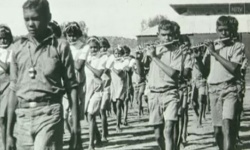IND/The Continuing Impact of Removal
The impact of child removal on Indigenous people who were removed, the descendants of those children, and the communities from which they were taken, is profound and ongoing.
| “ | There was a disruption of our cycle of life because we were continually scared to be ourselves. During the raids on the camps it was not unusual for people to be shot - shot in the arm or the leg. You can understand the terror that we lived in, the fright - not knowing when someone will come unawares and do whatever they were doing - either disrupting our family life, camp life, or shooting at us. | ” |
Confidential evidence 681, Western Australia: woman ultimately surrendered at 5 years to Mt Margaret Mission for schooling in the 1930s, (quoted in HREOC, 1997, Chapter 2).
- Consider the quote above; what impact do you think living in fear that children would be removed would have on Aboriginal families?
Many of the members of the Stolen Generations were not provided with any information about their family or communities, so finding out that they are Indigenous creates complex issues of identity.
Dudgeon, P. & Hirvonen, T. (2014). Why me; why was I taken? It’s like a hole in your heart that never heal. In InPsych. August 2014.
Some of the most powerful accounts of the impact of the Stolen Generations come from Indigenous artists:
Audiovisual clip titled ‘Took the Children Away’ with music by Archie Roach:
Audiovisual clip of ‘Brown Skin Baby (They Took Me Away)’ by Bob Randall:
